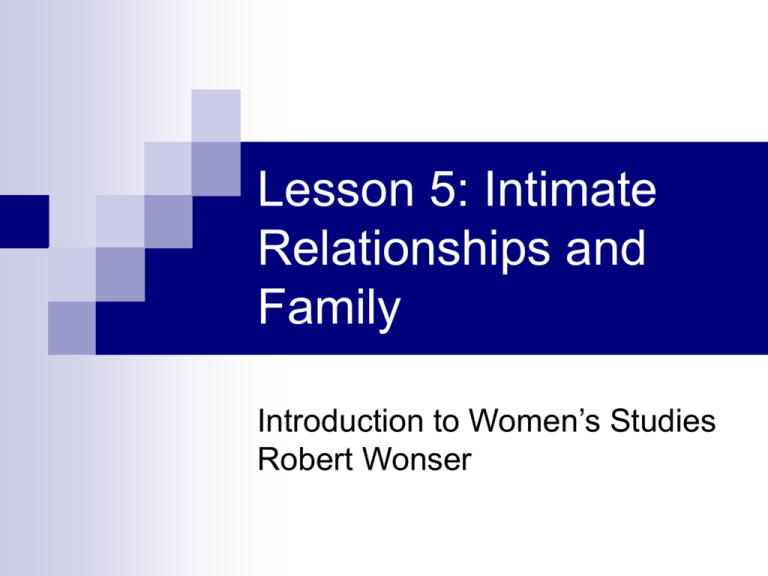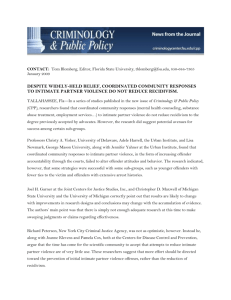
Lesson 5: Intimate
Relationships and
Family
Introduction to Women’s Studies
Robert Wonser
Erotic Relations are Historical
Relations
Sexuality has changed and evolved
historically
that
it, is not universal and fixed
This removes bodies from the biological
realm and places them firmly in the social
realm.
Lesson 5: Intimate Relationships and
Family
2
Did you know?
Heterosexual and homosexual were invented in the late
nineteenth century by doctors and scientists who created
the science of sexology.
Before that time people engaged in homosexual and
heterosexual acts but their acts did not adhere to them as
identities.
Initially heterosexuals were defined as people only
interested in sex for pleasure. Term was used to
distinguish them from the time’s ‘normals’ who only
engaged in sex for procreation.
The socioeconomic organization of society—not genes,
not brains—created the conditions for living heterosexual
and gay or lesbian lives.
Lesson 5: Intimate Relationships and
Family
3
Gendered sexualities
Like gender, sexualities are also expected
to be “opposite”, and gendered
Compulsory heterosexuality – the
dominance of heterosexual values, and the
fact that both hetero- and nonheterosexuality are shaped by dominant
social scripts
Dichotomy
between heterosexuality and
homosexuality only began in 19th century
When is there an exception to this?
Lesson 5: Intimate Relationships and
Family
4
Lesbian or Bisexual Chic
Illustrates a mismatch between sexual behavior
and sexual identity
Paula Rust defines this phenomenon as “samesex behavior engaged in by essentially
heterosexual individuals under certain
extenuating circumstances, in keeping with the
cultural belief that there are only two true forms
of sexuality”
Behavior is most likely found “in a cultural milieu
favoring sexual experimentation.”
Lesson 5: Intimate Relationships and
Family
5
Lesbian or Bisexual Chic
Is this cultural acceptance of “girl-on-girl”
progressive?
Or are the images marketed for heterosexual
male audiences and focused on using women to
pleasure men (Luscombe 2004)?
Does this perpetuate the myth that bisexuality is
simply a phase and not a valid sexual identity?
On the other hand, is it subversive in that it
challenges compulsory heterosexuality?
Lesson 5: Intimate Relationships and
Family
6
Sex Talk
Who’s genitals do we have more names for, men
or women?
Gender differences are embedded in the
language of sex that is the words, expressions,
and ways we talk about sex.
How do we describe heterosexual sexual
intercourse?
The talk reflects traditional gender relations,
specifically that of man the aggressor/initiator
and the woman as a passive receptor.
Lesson 5: Intimate Relationships and
Family
7
Sexuality and Sexual Orientation:
Gendering Desire
Is sexuality based in our biology?
If
so, how much is?
Or is it structured socially instead of by nature?
What
does it mean to say that something that seems
to ‘come from within’ is in some measure a social
construction (that is, coming from the outside)?
Several ways to answer this:
Marrying
biology and society, scripts, showing how
sexed bodies are socially produced and finally, the
changing histories of sexuality.
Lesson 5: Intimate Relationships and
Family
8
Basis of Sexuality
Is not “either-or” but “both-and”
According to anthropologist Clifford Geetz, humans are
“incomplete or unfinished animals who complete or finish
ourselves through culture.”
Biology is only part of the context of desire.
A complex mix of anatomy, hormones, and the brain
provide the basic outline for the range of acts and
desires possible but biology is neither where sexuality
begins nor where it ends.
Social situations can produce biological responses; e.g.
military and homosexual men with similar levels of
testosterone or the tennis match.
Lesson 5: Intimate Relationships and
Family
9
Sexuality is socially scripted
Sexuality is governed by sexual “scripts” derived from
socially learned gender roles.
Sexuality is the outcome of learning a sexual “vocabulary
of motives” in adolescence, when young people are
socially defined as potential sexual actors.
We must learn to recognize sexual feelings and desires
and learn how to translate them into socially validated
actions.
To whom are we supposed to be attracted to?
When/where do we have sex? Cues?
Boys learn to conquest, girls expect romance.
Lesson 5: Intimate Relationships and
Family
10
Bodies are produced within society
Produced through “body-reflexive practices”
The physical body is enmeshed in a social world of
practices and activities that have physical outcomes
regarding sexuality, reproduction and masculinity or
femininity.
Bodies are sites or arenas of social practice, in which
bodies are brought into social processes (Connell 2002)
Ex: steroids, diet pills, genital and cosmetic surgeries
shape bodies.
Stop, how are you all seated? Like men and women?
We informally learn gestures and nonverbal forms of
communication that become our sometimes unconscious
repertoires of gendered and sexualized body practice.
Lesson 5: Intimate Relationships and
Family
11
Connell continued
Sexuality is learned
Sexual arousal and sexual turn-offs are bodily
responses mediated by social relationships.
Our sexed bodies are produced in society and
often announce to society our gendered
identities and our sexual selves.
“hegemonic masculinity appropriates Steve’s
body and gives it a social definition.”
Lesson 5: Intimate Relationships and
Family
12
Sexual Scripts
Constructionist view; the categories we believe to be real
are socially constructed.
Gagnon and Simon’s (1973) theory of sexual scripts
holds that sexual relations are scripted interactions
based on prevailing gender ideologies.
Comes out of Goffman’s dramaturgy
Have you ever noticed how sexual interactions unfold in
a predictable manner? We’re all aware of the
expectations and how we’re supposed to behave.
Men are supposed to be dominant sexual initiators and
women as sexually shy, submissive and as gatekeepers.
In Western culture sex means love and intimacy for
women and orgasm and physical pleasure for men.
Lesson 5: Intimate Relationships and
Family
13
Other Sexual Scripts
Violent Scripts help explain gendered patterns of
violence
The emphasis on men’s initiation and pleasure in
traditional scripts is thought to be linked to men’s
sexual aggression.
Men are supposed to be demanding sex and
women as the sexual gatekeeper and passive
recipient.
Create barriers to egalitarian heterosexual
relationships and some evidence that they play a
part in rape and sexual violence.
Ex: “she asked for it” and “no really means yes”
Lesson 5: Intimate Relationships and
Family
14
Judith Butler
Challenges the claim that homosexuality is as
“natural” as heterosexuality because ALL of it,
heterosexual and homosexual are “un-natural”.
They are performances not essences.
We produce the illusion of gendered essences in
performing them. They’re no more “real” than the
performance.
Gender is nothing but the performance of
gender
Lesson 5: Intimate Relationships and
Family
15
Problem with term “Homophobia”
Problem with the term homophobia
because it literally means “fear of
homosexuals” – hatred, anger, and
aggression are stronger components
than fear.
Not just a mislabel but helps excuse
hostile behavior as the (understandable)
result of inescapable fear (Logan 1996).
Lesson 5: Intimate Relationships and
Family
16
Heterosexism
Homophobia refers to individual beliefs and
behaviors, not institutionalized discrimination.
Heterosexism refers to the antihomosexual
beliefs and practices embedded in social
institutions.
Similar to “white privilege”; we’re not taught to
see how racism puts some in a position of
privilege but rather view it as something that
puts racial ethnic minorities at a disadvantage.
Lesson 5: Intimate Relationships and
Family
17
Examples of Heterosexual Privilege
You can go wherever you want and know that
you will not be harassed, beaten, or killed
because of your sexuality
You do not have to worry about being
mistreated by the police or victimized by the
criminal justice system because of your
sexuality
You can express affection (kissing, hugging,
and holding hands) in most social situations
and not expect hostile or violent reactions
from others
Lesson 5: Intimate Relationships and
Family
18
Heterosexual Privilege
You are more likely to see sexually-explicit images of
people of your sexuality without these images provoking
public consternation or censorship
You can discuss your relationships and publicly
acknowledge your partner (such as by having a picture of
your lover on your desk) without fearing that people will
automatically disapprove or think that you are being
“blatant”
You can legally marry the person whom you love
You can receive tax breaks, health insurance coverage,
and spousal legal rights through being in a long-term
relationship
You can express yourself sexually without the fear of being
prosecuted for breaking the law
Lesson 5: Intimate Relationships and
Family
19
Heteronormativity
Heteronormativity
refers to the
invisibility of
same-sex couples
in social life.
Lesson 5: Intimate Relationships and
Family
20
Doing the Work of Family
Many types of work
(both paid and
unpaid) are necessary
to keep a family
operating.
These tasks can be
either instrumental or
expressive.
Lesson 5: Intimate Relationships and
Family
21
21
Doing the Work of Family
Instrumental tasks refer to the practical
physical tasks necessary to maintain
family life (washing dishes and cutting
grass).
Expressive tasks refer to the emotional
work necessary to support family
members (remembering a relative’s
birthday or playing with the kids).
Lesson 5: Intimate Relationships and
Family
22
22
Doing the Work of Family (cont’d)
Men and women have always performed different
roles to ensure the survival of their families, but
these roles were not considered unequal until
after the Industrial Revolution.
Work started taking place outside of the home, for
a paid wage.
As a result, the kind of work that became valuable
was the kind that happened outside of the home.
This is when “housework” became unvalued,
because it was not associated with a wage.
Lesson 5: Intimate Relationships and
Family
23
23
Doing the Work of Family (cont’d)
Women nowadays have
two jobs: paid labor
outside the home and
unpaid labor inside the
home.
Second shift (unpaid
labor inside the home
that is often expected of
women after they get
home from working at
paid labor outside the
home).
Many women juggle fulltime jobs with caring for
their children and running
their home with little help
from their spouses.
According to Arlie
Hochschild, what are the
consequences of the
supermom strategy?
Lesson 5: Intimate Relationships and
Family
24
24
The “stalled revolution”
Sociologists use the term “stalled revolution” to
describe how current state of the feminist
movement.
It’s “stalled” in that, while women are (mostly)
free to do what men do, men have been much
more reluctant to do what women have
traditionally done.
This makes sense because masculine things are
generally valued and feminine things are not.
Like
housework
Lesson 5: Intimate Relationships and
Family
25
Lesson 5: Intimate Relationships and
Family
26
Mother/daughter bonding... Over
cleaning
Lesson 5: Intimate Relationships and
Family
27
Trends in Housework since 1900
Lesson 5: Intimate Relationships and
Family
28
28
Lesson 5: Intimate Relationships and
Family
29
Lesson 5: Intimate Relationships and
Family
30
Eat Dinner at Home or Eat Out?
Lesson 5: Intimate Relationships and
Family
31
31
Trouble in Families
Domestic violence is by far the most
common form of family violence. It includes
behaviors abusers use to gain and maintain
power over their victims. Abuse can be:
Physical
Verbal
Financial
Sexual
Psychological
Lesson 5: Intimate Relationships and
Family
32
32
Trouble in Families
Rates of domestic violence are about equal across racial and
ethnic groups, sexual orientations, and religious groups.
People are more likely to be killed or attacked by family members
than anyone else.
5.9 out of every 1,000 and 2.1 out of every 1,000 men experience
domestic violence
60% of offenses occur between 6 p.m. and 6 a.m. in the victim’s home
In 2005, 1,181 women and 329 men were killed by their intimate
partners
Domestic violence calls are the single largest category of calls to the
police
Only a very small number of domestic violence incidents are reported
to the police
- National Institute of Justice Special Report June 2009
Lesson 5: Intimate Relationships and
Family
33
33









